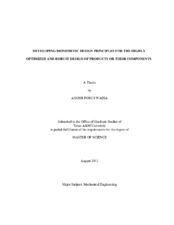| dc.description.abstract | Engineering design methods focus on developing products that are innovative, robust, and multi-functional. In this context, the term robust refers to a product's ability to accomplish successfully its predetermined functions. Owing to the abundance of optimized and robust biological systems, engineering designers are now looking to nature for inspiration.
Researchers believe that biomimetic or bio-inspired engineering systems can leverage the principles, mechanisms, processes, strategies, and/or morphologies of nature's successful designs. Unfortunately, two important problems associated with biomimetic design are a designer's limited knowledge of biology and the difference in biological and engineering terminologies. This research developed a new design tool that addresses these problems and proposes to help engineering designers develop candidate bio-inspired products or solutions.
A methodology that helps users infer or extract biomimetic design principles from a given natural system or biomimetic product pair is described in this thesis. The method incorporates and integrates five existing design tools and theories to comprehensively investigate a given natural system or biomimetic product. Subsequently, this method is used to extract biomimetic design principles from 23 biomimetic products and natural systems.
It is proposed that these principles have the potential to inspire ideas for candidate biomimetic products that are novel, innovative, and robust. The principle extraction methodology and the identified principles are validated using two separate case studies and a detailed analysis using the validation square framework.
In the first case study, two students and the author use the principle extraction methodology to extract characteristics from a natural system and a biomimetic product pair. Results from this case study showed that the methodology effectively and repeatedly identifies system characteristics that exemplify inherent biomimetic design principles. In the second case study, the developed biomimetic design principles are used to inspire a solution for an engineering design problem. The resulting solution and its evaluation show that the design's achieved usefulness is linked to applying the biomimetic design principles.
Similar to the TRIZ principles, the biomimetic design principles can inspire ideas for solutions to a given problem. The key difference is that designers using TRIZ leverage the solution strategies of engineering patents, while designers using the biomimetic design principles leverage nature’s solution strategies. The biomimetic design principles are compared to TRIZ and the BioTRIZ matrix. | en |


